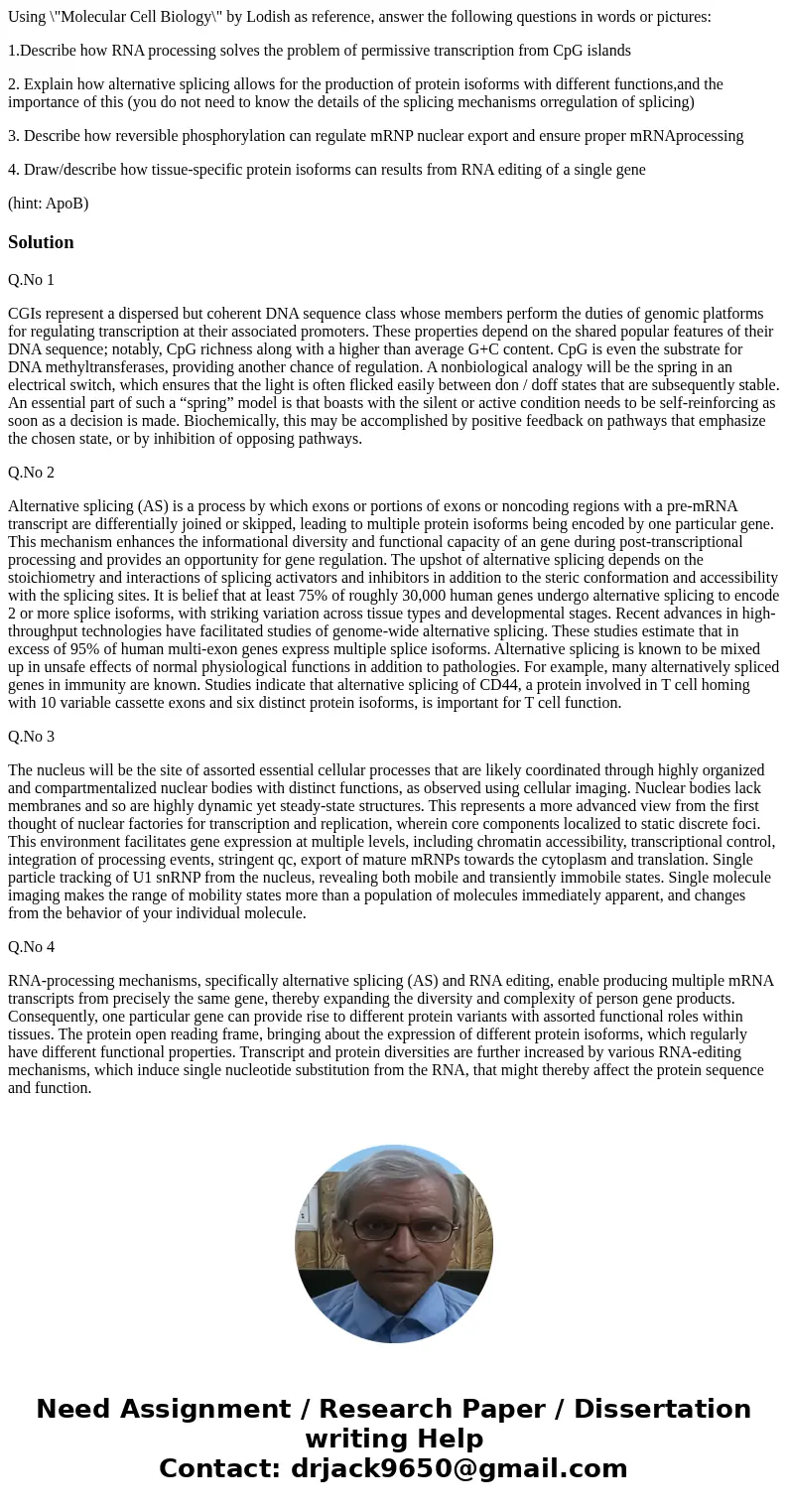Using Molecular Cell Biology by Lodish as reference answer t
Using \"Molecular Cell Biology\" by Lodish as reference, answer the following questions in words or pictures:
1.Describe how RNA processing solves the problem of permissive transcription from CpG islands
2. Explain how alternative splicing allows for the production of protein isoforms with different functions,and the importance of this (you do not need to know the details of the splicing mechanisms orregulation of splicing)
3. Describe how reversible phosphorylation can regulate mRNP nuclear export and ensure proper mRNAprocessing
4. Draw/describe how tissue-specific protein isoforms can results from RNA editing of a single gene
(hint: ApoB)
Solution
Q.No 1
CGIs represent a dispersed but coherent DNA sequence class whose members perform the duties of genomic platforms for regulating transcription at their associated promoters. These properties depend on the shared popular features of their DNA sequence; notably, CpG richness along with a higher than average G+C content. CpG is even the substrate for DNA methyltransferases, providing another chance of regulation. A nonbiological analogy will be the spring in an electrical switch, which ensures that the light is often flicked easily between don / doff states that are subsequently stable. An essential part of such a “spring” model is that boasts with the silent or active condition needs to be self-reinforcing as soon as a decision is made. Biochemically, this may be accomplished by positive feedback on pathways that emphasize the chosen state, or by inhibition of opposing pathways.
Q.No 2
Alternative splicing (AS) is a process by which exons or portions of exons or noncoding regions with a pre-mRNA transcript are differentially joined or skipped, leading to multiple protein isoforms being encoded by one particular gene. This mechanism enhances the informational diversity and functional capacity of an gene during post-transcriptional processing and provides an opportunity for gene regulation. The upshot of alternative splicing depends on the stoichiometry and interactions of splicing activators and inhibitors in addition to the steric conformation and accessibility with the splicing sites. It is belief that at least 75% of roughly 30,000 human genes undergo alternative splicing to encode 2 or more splice isoforms, with striking variation across tissue types and developmental stages. Recent advances in high-throughput technologies have facilitated studies of genome-wide alternative splicing. These studies estimate that in excess of 95% of human multi-exon genes express multiple splice isoforms. Alternative splicing is known to be mixed up in unsafe effects of normal physiological functions in addition to pathologies. For example, many alternatively spliced genes in immunity are known. Studies indicate that alternative splicing of CD44, a protein involved in T cell homing with 10 variable cassette exons and six distinct protein isoforms, is important for T cell function.
Q.No 3
The nucleus will be the site of assorted essential cellular processes that are likely coordinated through highly organized and compartmentalized nuclear bodies with distinct functions, as observed using cellular imaging. Nuclear bodies lack membranes and so are highly dynamic yet steady-state structures. This represents a more advanced view from the first thought of nuclear factories for transcription and replication, wherein core components localized to static discrete foci. This environment facilitates gene expression at multiple levels, including chromatin accessibility, transcriptional control, integration of processing events, stringent qc, export of mature mRNPs towards the cytoplasm and translation. Single particle tracking of U1 snRNP from the nucleus, revealing both mobile and transiently immobile states. Single molecule imaging makes the range of mobility states more than a population of molecules immediately apparent, and changes from the behavior of your individual molecule.
Q.No 4
RNA-processing mechanisms, specifically alternative splicing (AS) and RNA editing, enable producing multiple mRNA transcripts from precisely the same gene, thereby expanding the diversity and complexity of person gene products. Consequently, one particular gene can provide rise to different protein variants with assorted functional roles within tissues. The protein open reading frame, bringing about the expression of different protein isoforms, which regularly have different functional properties. Transcript and protein diversities are further increased by various RNA-editing mechanisms, which induce single nucleotide substitution from the RNA, that might thereby affect the protein sequence and function.

 Homework Sourse
Homework Sourse